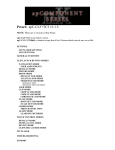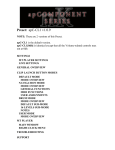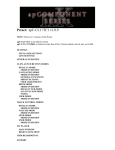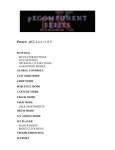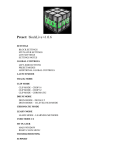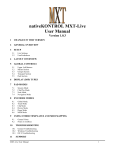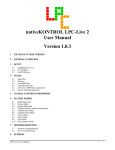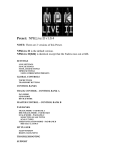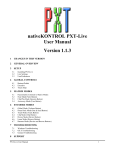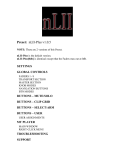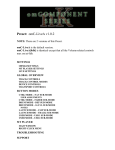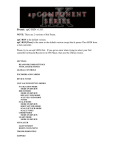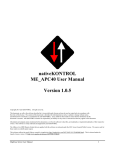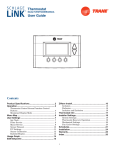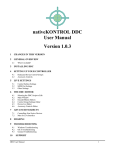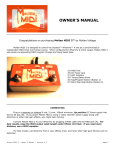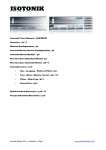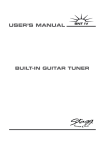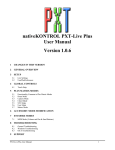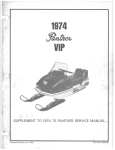Download nativeKONTROL apC
Transcript
Preset: apC-CL3 v1.1.3 NOTE: There are 2 versions of this Preset. apC-CL3 is the default version. apC-CL3[0db] is identical except that all the Volume-related controls max out at 0db. SETTINGS MT PLAYER SETTINGS LIVE SETTINGS GENERAL OVERVIEW CLIP LAUNCH BUTTON MODES NAVIGATION MODE USER ASSIGNMENTS DEFAULT MODE METERS MODE DRUM MODE DEFAULT SUB-MODE 16 LEVELS SUB-MODE SEQUENCE SUB-MODE SEQUENCE JOBS SEQUENCE EDIT SUB-MODE USER MODE CLIP MODE CHOP 16 SUB-MODE CHOP 32 SUB-MODE CHROMATIC SUB-MODE SCALE MODE ROOT SET SUB-MODE SCALE SET SUB-MODE CHORD MODE MIDI CHANNEL INFO LEARN MODE LEARNING METHODS MT PLAYER TROUBLESHOOTING SUPPORT SETTINGS If you have trouble completing any of the settings listed here, please make sure to refer to the Troubleshooting section. MT PLAYER SETTINGS The first time you use your APC40 in MT Player, you may be prompted to setup the APC40’s ports. For both prompts, you should select your APC40. However, if you bypass those prompts, you can access the settings by rightclicking on MT Player and selecting MIDI Settings. 1. 2. 3. 4. 5. 6. From the Port Name menu, select “IN: APC40 Input”. From the MIDI In port menu, select your APC40 and click OK. Go back into MIDI Settings. From the Port Name menu, select “OUT: APC40 Output”. From the MIDI Out port menu, select your APC40 and click OK. Click the Restart button. You can learn more about MT Player in the MT Player section. LIVE SETTINGS The following settings will be found in Preferences on the MIDI/Sync tab. IMPORTANT NOTE: When you first install MT Player, Live will automatically turn on its Track switches. Before completing the steps below, turn off all the Track switches related to MT Player. 1 1. Turn off all of the Track/Sync/Remote switches related to your APC40 and deselect it as a Control Surface. 2. Select APC40 as a Control Surface. 3. Select From MT Player 1 as the Input and To MT Player 1 as the Output. 4. Select apC Series as a Control Surface. 5. Select From MT Player 2 as the Input and To MT Player 2 as the Output. 6. Turn on the Remote switches for APC40 Input (From MT Player 1) and APC40 Output (To MT Player 1). 7. Turn on the Track switches for apC_Series Input (From MT Player 2) and apC_Series Output (To MT Player 2). NOTE: It is recommended that you launch MT Player, select a Preset and then launch Live. If Live is already running when you select or Restart a Preset, it is recommended that you enter, then exit MIDI mapping mode after selecting the Preset to re-initialize. Also, in order to avoid conflicts with the APC’s default functions, it is recommended that you set up any other controllers you might be using for MIDI mapping to operate on MIDI channels 9 – 16. GENERAL OVERVIEW This Preset offers nine Modes for the APC40’s Clip Launch Buttons. Eight of these Modes can be switched between by holding down Shift and using the Clip Stop Buttons. (When switching between Modes, the Mode won’t actually change until you release the Shift button.) Also, when Shift is depressed, the Clip Stop Button LEDs will indicate the currently selected Mode. Also, the Status Bar (left lower corner) in Live will indicate Mode names as you’re switching between them. The ninth Mode (Navigation Mode) can be accessed by pressing Master. This Mode can be accessed from any of the Clip Launch Button Modes. NOTE: All of the APC40’s other controls perform their default function in every Mode with the following exceptions: 2 MASTER – Switches to Navigation Mode. SHIFT+MASTER – Selects Master Track. MUTE/SOLO BUTTONS – These Buttons provide dual functionality. Press them relatively quickly and they will toggle. Hold them down and they become momentary switches. DEVICE ON/OFF BUTTON – This Button provides dual functionality like the Mute Buttons described above. SHIFT+NUDGE +/- – Increase/decrease Global Quantization value. RECORD QUANTIZATION +NUDGE +/- – When the Record Quantization Button is held down, the Nudge +/- Buttons can be used for setting your Record Quantization value. As you’re changing this value, the new value will be shown in the Status Bar (left lower corner) in Live. SHIFT+TAP – Toggle Global Quantization on/off. SHIFT+CUE LEVEL – Session = Scene select. Arrange = Scroll. METRONOME+CUE LEVEL – When the Metronome Button is held down, Cue Level will adjust Tempo in 1-BPM increments. SHIFT+PLAY – Start playing from the stop point. SHIFT+STOP – Undo. SHIFT+REC – Launch the selected Clip. If the selected Track is armed, the selected Clip Slot has no Clip and Global Quantization is set to a value other than None, this will trigger Clip Record. Clip Record will create a new Clip with a length that is equal to the Global Quantization value. SHIFT+STOP ALL – This is User Assignable to Live menu functions. Please see User Assignments. FADERS – The Faders perform their default function. However, pressing Shift will Mute the Faders so that they can be repositioned. This is sort of a manual Takeover mode so, when using it, Takeover mode in Live should be set to None. NOTE: In addition to the exceptions listed here, some of the Clip Launch Modes utilize the Scene Launch Buttons and/or the Clip Stop Buttons. 3 CLIP LAUNCH BUTTON MODES NAVIGATION MODE MODE OVERVIEW This Mode provides a variety of controls for navigating Live sets, launching/recording Clips/Scenes and general-purpose editing. This Mode can be accessed from any other Mode by pressing Master. You will only be in this Mode while Master is held down. If you’d like to lock into this Mode, while holding down Master, press Shift. To unlock, press Master. GENERAL FUNCTIONS COPY/PASTE/DUPE/DEL/UNDO/REDO – Standard editing shortcuts. USER 1 – 8 – These Buttons are User Assignable to Live menu functions. Each Button can be assigned a Default function and a Shifted function. Please see User Assignments. PLUS/PG UP – Plus/page up keystrokes. MINUS/PG DN – Minus/page down keystrokes. KEY UP/DOWN/LEFT/RIGHT – Arrow keystrokes. ENTER/ESCAPE – Enter/escape keystrokes. LOAD CLIP – Load selected Clip(s) from browser onto selected Clip Slot(s). 4 SHIFT/CTRL/WIN/CMD/ALT – Modifier keystrokes. These can be used to modify the function of the Arrow keystrokes as well as mouse movements/clicks. FOCUS CONTROLS – These 3 controls move Live’s focus to different areas so that you can navigate/control them with the keystrokes explained above. MAIN FOCUS – Puts the focus on Live’s main window. FIX – Puts the focus back on the main element in Live’s main window. DETAIL FOCUS – Puts the focus on Clip View or Track View. BRWSR FOCUS – Puts the focus on Live’s Browser. MIDI FUNCTIONS SSN/ARNG – Toggle between Session and Arrange Views. CLIP/TRACK – Toggle between Clip and Track Views. BRWSR I/O – Show/hide the Browser. TGL BRWSR/PREV – Toggle to the next/previous browser in Live 8 (these buttons have no function in Live 9). This requires some additional setup as explained in User Assignments. MCU UP/DOWN/LEFT/RIGHT – These are multi-functional cursor Buttons. When in Session View, these will navigate. When in Arrange View, these with navigate up and down and zoom left and right. PREV L/NEXT L – Jump to the Previous/Next Locator. CLIP LNCH – Launch the selected Clip. If the selected Track is armed, the selected Clip Slot has no Clip and Global Quantization is set to a value other than None, this will trigger Clip Record. Clip Record will create a new Clip with a length that is equal to the Global Quantization value. SCN LNCH – In Session View, this will launch the currently selected Scene. TEMPO UP/DOWN – Increase/decrease Tempo by 1-BPM. 5 USER ASSIGNMENTS WINDOWS: In order to use Tgl Browser/Prev and/or User 1 – 8, you will need to download and install Live Menu Keys: http://beatwise.proboards.com/index.cgi?board=freesoft&action=display&thread=1131 Live Menu Keys will automatically configure Tgl Browser/Prev for you. To configure User 1 – 8, double-click the Live Menu Keys icon to open its configuration window and click the Add HotKey button. Press one of the User Buttons or Shift+one of the User Buttons to assign the HotKey. After the HotKey, you’ll list the menu item the HotKey should trigger. OS X: You can configure Tgl Browser/Prev and User Buttons 1 – 8 by using a utility built into the OS. To configure User Buttons 1 – 8, go to System Preferences – Keyboard & Mouse and click on the Keyboard Shortcuts tab. Scroll down to Application Keyboard Shortcuts and click the Plus button to add a new shortcut. The Application for all the shortcuts should be Live. Type the Menu Title exactly as it appears in Live’s menu. Assign the Keyboard Shortcut by pressing one of the User Buttons or Shift+one the User Buttons. To configure Tgl Browser/Prev, you will need to set up 6 additional shortcuts. The Keyboard Shortcut and Menu Titles are as follows: Ctrl+Alt+F1 = Live Devices Ctrl+Alt+F2 = Plug-In Devices Ctrl+Alt+F3 = Files 1 Ctrl+Alt+F4 = Files 2 Ctrl+Alt+F5 = Files 3 Ctrl+Alt+F6 = Hot-Swap NOTE: The names above are shown in English. If you are using a different language in Live, the names will be different. You can see these names by going to View – Browser. NOTE: For OS X users, once you’ve made all your assignments, you’ll need to close and restart Live for them to take effect. 6 DEFAULT MODE MODE OVERVIEW In this Mode, the Clip Launch Buttons perform their default function. METERS MODE MODE OVERVIEW In this Mode, the top 2 rows of Clip Launch Buttons will function as a level meter for the selected Track. The bottom 2 rows of Clip Launch Buttons will function as a level meter for the Master Track. 7 DRUM MODE MODE OVERVIEW This Mode provides Drum Machine-like control via 3 Sub-Modes; Default, 16 Levels and Sequence. It also utilizes the concept of “Last Pad”, which is the last pad that was triggered. NOTE: Drum Mode modifies the function of the APC40’s Scene Launch buttons. The Sequence Sub-Mode also uses the Clip Stop buttons. Also, due to the way this Mode functions, you will not be able to edit notes in MIDI clips with your mouse as you normally would. In particular, your ability to move and resize notes will be restricted. For that reason, it’s recommended you exit this Mode in order to edit notes with your mouse. NOTE LAYOUT The Drum Pads in this Mode provide access to six 4 x 4 grids. These grids can be selected via the Scene Launch buttons. The note ranges of the grids are as follows: Scene Launch 1 (pressed twice)* Scene Launch 1 (pressed once)* Scene Launch 2 Scene Launch 3 (default grid) Scene Launch 4 Scene Launch 5 C5 – D#6 G#3 – B4 E2 – G3 C1 – D#2 G#-1 – B0 E-2 – G-1 *As shown above, Scene Launch 1 can access 2 different grids. When pressed once, the G#3 – B4 grid will be selected and Scene Launch 1 will be lit. When pressed twice, the C5 – D#6 grid will be selected and Scene Launch 1 and 2 will be lit. The Drum Pads can send the notes above to trigger the Drum Rack (or other drum plugin). They can also provide feedback on the status of note lanes in the selected MIDI Clip. A note lane is a horizontal row of notes in a MIDI Clip. For example, all of the C1 notes in a Clip make up one note lane, all of the D#2 notes make up another note lane. If the default grid is selected (Scene Launch 3 LED is lit), the Drum Pad in the lower left hand corner will display the status of the C1 note lane while the Drum Pad in the upper right hand corner will display the status of the D#2 note lane. 8 DEFAULT SUB-MODE DEF/16 LVL/SEQ – Switch between Default, 16 Levels and Sequence SubModes. VELOCITY LEVEL – Set the Velocity Level of the Drum Pads and Last Pad 1 – 4. GRID SELECT – Select the 4x4 grid for the Drum Pads to control/display. Upon switching between grids, the first note lane in the grid will be selected. DRUM PADS – These 16 Buttons send out MIDI notes (as explained on the previous page). They also indicate the status of note lanes in the selected MIDI Clip. If a note lane is active, the corresponding Drum Pad will be green. If any notes in the note lane are muted, the corresponding Drum Pad will be unlit. The Drum Pads can also be used to provide playback feedback. In order to accomplish this: 1. Right-click on your Drum Rack (or drum plugin) and select Group to create an Instrument Rack. 2. Add an External Instrument Rack to the Instrument Rack. 3. Set the External Instrument Rack to send MIDI To To MT Player 2 on Ch 1. LAST PAD 1– This will trigger the Last Pad. This makes it so you have at least 2 Buttons to use to play fast rolls and such. LOCK 1– This will lock Last Pad 1. This makes it so Last Pad 1 stays locked on the current pad. When locked, Last Pad 1 will be lit red. 9 LAST PAD 2 – 4 – Same as Last Pad 1. LOCK 2 – 4 – Same as Lock 1. NOTE MUTE – Press and hold this Button and then press a Drum Pad to mute the corresponding note lane in the selected Clip. UNMUTE – Unmute any muted note lanes in the selected Clip. NOTE ERASE – While the selected Clip is playing back, press and hold this Button and then press a Drum Pad to erase the portion of notes in the corresponding note lane that the playhead is currently passing over. NOTE DELETE – Press and hold this Button and then press a Drum Pad to delete the corresponding note lane from the selected Clip. Note Delete will not delete a note lane if it’s the only note lane in the selected Clip. 16 LEVELS SUB-MODE DEF/16 LVL/SEQ and VELOCITY LEVEL and GRID SELECT – Same as in Default Sub-Mode. SLCT ONLY – Press and hold this Button and then press a Drum Pad to select a note without triggering the Drum Rack (or other drum plugin). DRUM PADS/NOTE SELECT – Same as in Default Sub-Mode except the Drum Pads will also select the note for the 16 Levels Pads to play. The Drum Pad corresponding to the selected note will flash green. 16 LEVELS PADS – The selected note will be assigned to all 16 of these Buttons, each with a different level of velocity. 10 SEQUENCE SUB-MODE This Sub-Mode allows you to steq-sequence into the selected MIDI Clip. It requires that the Clip be in 4/4, its Loop must be on and the length of the Loop must be 1 Bar or greater. It supports Clips up to 8 Bars long. It can be used with Clips that are longer than 8 Bars, but can only edit the first 8 Bars. This Sub-Mode also includes its own Edit Sub-Mode that you can access by holding down Shift. DEF/16 LVL and GRID SELECT – Same as in Default Sub-Mode. SLCT ONLY – Press and hold this Button and then press a Drum Pad to select a note without triggering the Drum Rack (or other drum plugin). ZOOM – By default, the Button layout will be as shown in the picture above and the resolution of the steps will be 1/16th notes. When Zoom is turned on (LED will be amber), all of the Buttons on the bottom 4 rows are used for Step Input and the resolution of the steps will be 1/32nd notes. STEP LEVEL – Set the Velocity Level used when turning on steps. Each Button provides a fixed velocity (indicated by red LED) and a randomized velocity (indicated by green LED). DRUM PADS/NOTE SELECT – Same as in Default Sub-Mode except the Drum Pads will also select the note lane to step-sequence into. The Drum Pad corresponding to the selected note will flash green. 11 STEP INPUT – These Buttons will display/edit the notes in the selected note lane. The Buttons can display/edit 1 Bar at a time (selected via Bar To Edit). SEQUENCE JOBS Sequence Sub-Mode includes some extra editing functions known as Jobs. The Jobs all operate upon the selected note lane and the selected Bar. With the exception of the Extend Job, none of the Jobs will modify notes such that they spill over into other Bars. Any edits will only affect notes within the selected Bar. PREV/NEXT JOB – Navigate through the list of Jobs. The name of the selected Job will be shown in Live’s status bar. UNDO JOB – Press both Prev Job and Next Job to undo the last Job. DEC/INC DELAY TIME – Adjust the time of the Delay in subdivisions (such as 1/4 or Dotted 1/8th). The new setting will be shown in Live’s status bar. DEC/INC DELAY RPTS – Adjust the maximum number of Delay repeats. The new setting will be shown in Live’s status bar. DO JOB – Perform the selected Job. DELAY – Apply a delay to notes (a repeated note at descending velocities). The delay will only be applied where there is space for it. The space it has is limited by the note that follows the note to be delayed and the end of the Bar. Example of a note lane before and after applying the default delay settings (1/16th with 4 repeats). DELETE – Delete notes. EXTEND – Copy notes and paste them into the following bar. MUTE – Mute/Unmute notes. TIME - COMPRESS – Halve the length and positions of notes. TIME - REVERSE – Reverse the position of notes. TIME - SPLIT – Split notes into 2 equal parts. VELO - CRESCENDO – Apply ascending velocities to notes. VELO - DECRESCENDO – Apply descending velocities to notes. VELO - RANDOMIZE– Apply randomized velocities to notes. 12 SEQUENCE EDIT SUB-MODE BAR TO EDIT – Select the Bar (1 – 8) to edit. BAR(S) TO LOOP – Select the Bar(s) (1 – 8) to loop. When setting the Bar(s) to Loop, if the selected Clip is shorter than the Bar(s) to Loop setting, the selected Clip will be elongated. However, Clip View in Live will not automatically zoom out to show the entire Clip. SOURCE BAR – Select the Source Bar (1 – 8) to copy. If the selected Bar is empty, it will not be copied. DESTINATION BAR – Select the Destination Bar (1 – 8) to paste the copied Bar into. USER MODE MODE OVERVIEW In this Mode, the Clip Launch Buttons are user assignable in Live via MIDI mapping mode. CLIP MODE MODE OVERVIEW This Mode provides Clip control via 3 sub-modes; Chop 16, Chop 32 and Chromatic. Chop 16/32 will work with any type of Clip except for Audio Clips that aren’t warped. Also, Chop 16/32 will not work properly when using a Clip Quantization of None. Chromatic will work only with Audio Clips. NOTE: Clip Mode modifies the function of the APC40’s Scene Launch buttons. 13 CHOP 16 SUB-MODE CHOP 16/CHOP 32/CHROMATIC – Switch between Chop 16, Chop 32 and Chromatic Sub-Modes. CLIP LOOP – Toggle the selected Clip’s loop on/off. CLIP TGL – If the selected Clip is playing, this will stop it. Otherwise, this will launch the selected Clip. START SET – By default, all Clips are considered to have an initial start time of 1.1.1. You can override this by selecting a Clip, changing its start point and then pressing this Button. This will store the Clip with the modified initial start time and the Status Bar in Live will indicate the stored settings. To remove settings you’ve stored for a Clip, press Start Set a second time. XPOS +/- - Transpose the selected Audio Clip in one semitone increments. Press both of these to reset Transpose to 0. DETUNE +/- - Detune the selected Audio Clip in one cent increments. Press both of these (while holding down Shift) to reset Detune to 0. CHOP 16 PADS – The Pads will be assigned to 16 evenly distributed start points (based on the length of the selected Clip) for the selected Clip. NOTE: In both Chop 16 and Chop 32, if the selected Clip is playing, the Chop 16/32 Pads will show where the playhead is in relation to the Clip’s length. However, they will not provide this feedback until a Clip is selected and you’ve either launched it with the Chop 16/32 Pads or switched between Sub-Modes. 14 CHOP 32 SUB-MODE CHOP 16/CHOP 32/CHROMATIC and CLIP LOOP and CLIP TGL and START SET and XPOS +/- and DETUNE +/- – Same as in Chop 16 Sub-Mode. CHOP 32 PADS – The Pads will be assigned to 32 evenly distributed start points (based on the length of the selected Clip) for the selected Clip. CHROMATIC SUB-MODE CHOP 16/CHOP 32/CHROMATIC and CLIP LOOP and CLIP TGL and XPOS +/- and DETUNE +/- – Same as in Chop 16 Sub-Mode. CHROMATIC PADS – The Pads will transpose the selected Audio Clip. 15 SCALE MODE MODE OVERVIEW This Mode provides access to a variety of Scale Types. NOTE: Scale Mode modifies the function of the APC40’s Clip Stop buttons. SCALE – These 16 Buttons play the notes in the selected Scale. OCT UP/OCT DOWN – These Buttons will move the Scale up/down by 1 octave. MOD – This will quickly raise the Mod Wheel when pressed and return it to default (off) when released. PB DOWN/PB UP – These Buttons will quickly decrease/increase Pitch Bend when pressed and return it to default (off) when released. VELOCITY LEVEL – Same as Drum Mode. SUSTAIN – Sustain the currently held note(s). SCALE SET– Switch to the Scale Set sub-mode to choose a Scale Type. NOTE: By default, the Root Note for all Scales is C. To change the Root Note, press Shift to switch to the Root Set sub-mode. 16 ROOT SET SUB-MODE C – B – Select the Root Note of the Scale. SCALE SET SUB-MODE SCALE TYPE – The 40 Clip Launch buttons select the Scale Type. The Red LED indicates the selected Scale Type (which is Chromatic by default). Green LEDs indicate common Scale Types (Blues, Chromatic, Major and Minor) that are available for selection. Also, upon selecting a new Scale Type, the Status Bar in Live (lower left hand corner) will display the selected Scale Type. PREVIEW SCALE – Play a Preview of the selected Scale Type. SCALE PLAY – Switch back to the default Scale Mode. 17 CHORD MODE MODE OVERVIEW This Mode provides access to the 7 Scale Tone Chords for all Major/Minor Scales. NOTE: Chord Mode modifies the function of the APC40’s Clip Stop buttons. SCALE – These 8 Buttons will play one octave of the selected Scale. I – VII – These 7 Buttons will play the 7 Scale Tone Chords of the selected Scale. ROOT POS/1st INV/2nd INV – These 3 Buttons will select the Inversion of the Chords; Root Position, 1st inversion or 2nd inversion. CYCLE INV – This will cycle between the 3 Inversions of the Chords. PWR I/O – This will add/subtract a Power Chord to the Chords. SCALE HI/LO – This will switch the octave of the Scale Buttons. When the LED is off, the Scale will be 1 octave above the Chords (Hi). When the LED is on, the Scale will be 1 octave beneath the Chords (Lo). When Power I/O is on, the Scale Buttons will always be Hi. 18 MAJ/MIN – Switch between Major (the default) and Minor Scales. OCT DOWN/OCT UP and MOD and PB DOWN/PB UP and VELOCITY LEVEL and SUSTAIN– Same as in Scale Mode. NOTE: By default, the Root Note for all Scales is C. To change the Root Note, press Shift to switch to the Root Set sub-mode. MIDI CHANNEL INFO The Chords are sent on multiple MIDI channels. The highest note of the Chord is sent on Channel 1. The middle note on Channel 2. The lowest note on Channel 3. If Power Chord is on, the highest note of the Power Chord is sent on Channel 4. The lowest note of the Power Chord is sent on Channel 5. The Notes in the Scale are sent on Channel 6. This allows you to use the Chords in 2 ways; to play a single instrument or to play multiple instruments in an ensemble. To play a single instrument, just set the instrument up to receive from All (aka Any or Omni) MIDI channels. To play multiple instruments, set up each instrument to receive from an individual channel. For example: Flute – Channel 1 Viola – Channel 2 Cello – Channel 3 19 LEARN MODE MODE OVERVIEW This Mode allows you to learn Chords (up to 5 notes each) to the APC’s Clip Stop buttons. NOTE: Learn Mode modifies the function of the APC40’s Scene Launch and Clip Stop buttons. CHR 1 – This will play the Chord assigned to Chord 1. CHORD 1 – NOTES 1 – 5 – These Buttons will play the notes of the Chord assigned to Chord 1. LRN 1 – This will activate Learning for Chord 1. While Learning, the Chr 1 Button will flash and the Chord 1 – Notes 1 – 5 Buttons will light up to indicate each received notes. If more then 5 notes are received, the previous 5 notes will be erased. When finished Learning, press the Chr 1 button to store Chord 1. CHR 2 – 7 work in exactly the same way as Chord 1. VELOCITY LEVEL– Same as in Drum Mode. SUSTAIN – Sustain the currently held note(s) or chord(s). 20 OCT UP/DOWN – Transpose your learned chords/notes in one octave increments. Press both of these to reset. This cannot be changed while any notes/chords are being played. SEMI UP/DOWN – Transpose your learned chords/notes in one semi-tone increments. Press both of these to reset. This cannot be changed while any notes/chords are being played. LEARNING METHODS To learn chords by playing them from a 2nd controller: 1. Insert a MIDI Track and set it to send MIDI To To MT Player 2 on Ch 10. 2. Either Arm the Track or set its Monitor to In. 3. Activate learning for one of the chords and play the chord from your 2nd controller. You can play all the notes simultaneously or each one individually. To learn chords contained in a MIDI Clip: 1. Insert a MIDI Track and set it to send MIDI To To MT Player 2 on Ch 10. 2. Add the MIDI Clip containing the chords to this Track. 3. Activate learning for one of the chords and launch the Clip. MT PLAYER MAIN WINDOW The drop-down menu in the center of the window is used for selecting Presets (if multiple Presets are available). The last selected Preset will be selected the next time you launch Player. 21 The Restart button will restart a Preset and restore all of its default settings. The ? button will bring up the manual for the selected Preset. The IN and OUT indicators will light up to indicate MIDI activity. These are used for troubleshooting purposes. RIGHT-CLICK MENU MIDI Settings will bring up the MIDI Port Chooser window. Rescan MIDI devices will rescan MIDI devices on your system. This is useful in situations where your APC40 is not detected properly. Toggle Stats Display will show/hide event history. This is used for troubleshooting purposes. TROUBLESHOOTING 1. Why don’t I see apC_Series listed under Live’s Control Surface dropdown menu? You are asked to manually transfer the apC_Series script during install (instructions included in the Install Info pdf file). If you skipped that step or need to retransfer the script for some other reason, you can find it along with transfer instructions in: Windows – My Documents\Bome’s Midi Translator\Player. OS X – (your name)/Bome’s Midi Translator/Player. 2. When I try to complete the MT Player Settings steps, I get an error message when I select the APC40’s ports. Please close Live, MT Player and any other MIDI applications. Then relaunch MT Player and you’ll be able to complete the settings steps. 22 3. I have multiple copies of MT Player ports listed, which should I use? You should try to use the listings that start with “From” or “To”. For example, you shouldn’t use “3-From MT Player 1”, you should use “From MT Player 1”. In some cases, you will not have listings that start with “From” or “To”. 4. In the demo video I saw from you, you were using some functions that I don’t have. Where are they? Presets evolve over time in regard to refinements and new functionality. In some cases, it’s necessary to reposition existing controls to make way for new functions. We try to keep rearrangements to a minimum and any rearrangements will always be covered in the Preset’s manual. SUPPORT Email: [email protected] Forum: Beatwise Network Videos: Stray's YouTube Channel Copyright 2013-2014 nativeKONTROL. All rights reserved. This document, as well as the software described in it, is provided under license and may be used or copied only in accordance with the terms of this license. The content of this document is furnished for informational use only, is subject to change without notice, and should not be construed as a commitment by nativeKONTROL. Every effort has been made to ensure that the information in this document is accurate. nativeKONTROL assumes no responsibility or liability for any errors or inaccuracies that may appear in this document. All product and company names mentioned in this document, as well as the software it describes, are trademarks or registered trademarks of their respective owners. This software is solely endorsed and supported by nativeKONTROL 23
























